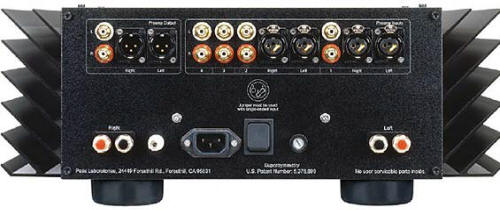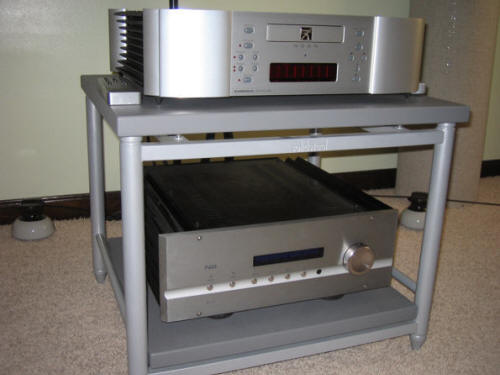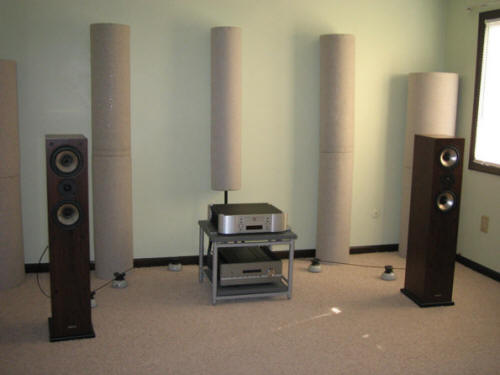
You are reading the older HTML site
Positive Feedback ISSUE
40november/december 2008
pass labs
INT-150 integrated
as reviewed by John Acton

|
JOHN ACTON'S SYSTEM
LOUDSPEAKERS
ELECTRONICS
SOURCES
CABLES
ACCESSORIES
|
My first and only experience with Pass Labs products has been as owner of an Aleph 30 power amplifier. Delivering 30 watts per channel of pure Class-A power, the Aleph 30 was sweet, resolving, and natural sounding. The amp's only limitations arose from its limited power output, and manifested themselves as a slightly truncated dynamic envelope and inability to drive inefficient speakers as unflinchingly as higher-powered models. Since those days, I've been interested in other Pass Labs offerings, but my preference for system-simplifying integrated amplification solutions has been at odds with Pass Labs' focus on separates. Until now, that is. Just this year, Pass Labs has introduced its first-ever integrated amplifier, the INT-150. Upon hearing of the INT-150, I worked with Pass Labs and Mark Sammut of Reno Hi-Fi to acquire one for evaluation.
In creating the INT-150, Nelson Pass and his design team chose to leverage existing technologies and topologies rather than opting to re-invent the wheel. Indeed, the INT-150 is, at its simplest, an X150.5 power amplifier mated to a buffered passive resistor-based volume attenuator and relay-switched input selector. What this means is that the INT-150 incorporates all the technological advances that have made the X.5 series of Pass Labs amplifiers so successful. Additionally, the input selector and volume attenuator are sourced from Pass Labs' newly-introduced XP-10 line-stage preamplifier.
The INT-150 employs a fully-balanced topology and leverages Pass Labs' patented Super-Symmetry circuit to supplement the common-mode rejection of balanced operation with controlled amounts of feedback at the amplifier outputs. Per Pass Labs, Super-Symmetry renders distortion artifacts as identical as possible and provides additional cancellation of noise. Rated at 150 watts per channel into 8 ohms and 300 watts per channel into 4 ohms, the INT-150 employs just two stages of gain and operates up to 15 watts per channel in Class A. Additionally, taking a cue from the flagship Pass Labs XA series of amplifiers, the integrated is biased so that the first few watts are output in single-ended Class A. The INT-150 is very robust and utilizes a massive power supply coupled to 20 MOSFET output devices per channel.
Externally, the Pass Labs INT-150 is very large for an integrated amplifier, and in spite of its exquisitely-finished faceplate and heat sinks, it looks fairly intimidating, and leaves no doubt that this is an amp that demands to be taken seriously. The front faceplate is brushed aluminum and minimalist in nature, containing just six buttons for source selection (inputs 1 through 4), mute and power/standby. A large knob controls volume in 1dB increments. The small horizontal window displays source and volume level and can be adjusted for varying degrees of brightness. The display can also be turned off, whereby it will briefly illuminate in response to user input before turning back off again.
Around the back, the INT-150 has connections for four high-level sources, two of which can be configured for either balanced or single-ended operation, the remaining two being single-ended only in nature. Small gold shorting jumpers are included in the event that the user wishes to utilize either of the balanced connections in a single-ended configuration. Two preamp-out connections are provided, one balanced and one single-ended, which allows the user to drive an external power amp or subwoofer from the INT-150's buffered volume control. No external tape loop connections are included. All line-level connectors are very high quality in nature. Two heavy-duty binding post speaker connectors are provided, but be aware that, to satisfy European Union requirements, they do not accept banana plug connectors. A separate ground connection is included. The unit's main power switch and IEC power inlet complete the lineup.

The chunky and elegant remote control is finished in brushed aluminum like the faceplate, and allows the user to control power, volume, channel balance and source selection. As the remote control is common to multiple Pass Labs products, some of the controls do not pertain to the INT-150.
The manual is extremely thorough and addresses every aspect of operation. Additionally, a fascinating history of Pass Labs and the company's founder, Nelson Pass, is included, culminating in a technical overview of the current X.5 amplifier line. This is one manual that does not feel like homework to read. The INT-150 is warranted by Pass Labs for a period of three years. To further put the user at ease, Pass Labs include a copy of the Quality Assurance Certificate, which details the results of bench and quality-assurance testing.
Setting up the INT-150 is remarkably easy. Simply plug in your source(s), connect your loudspeakers, hook up power and turn it on. But, be aware that the master power switch on the back panel simply places the amplifier into standby mode, keeping the power supply capacitors charged up and a minimal trickle of bias flowing to the output transistors. While the unit is technically fully powered up when in standby, the input relays, volume attenuator and display are all disabled. To take the amplifier out of standby, you must engage the power button on the front panel or remote control. Upon doing so, a small blue LED lights up, and the display illuminates. When in standby, the INT-150 runs barely warm to the touch, but fully activated, it quickly heats up due to its heavy Class-A bias. Pass Labs recommend letting the amplifier warm up for an hour before doing critical listening, and I concur with their recommendations. Be aware that the INT-150 runs hot and requires plenty of ventilation. My only quibble with the INT-150 from an operational standpoint is that its display can be a bit small to read from across the room, but as I typically turned the display off while listening, I wasn't too bothered by this. Also, from a wish-list perspective, it would have been neat if Pass could have figured out some way to include the pretty blue bias meter that is present on the X.5 and XA series of Pass Labs power amplifiers.

During the review period, my system comprised a SimAudio MOON Evolution SuperNova CD player, Ayre AX-7e, and conrad-johnson CA200 integrated amplifiers and Joseph Audio RM25XL Special Edition loudspeakers. Interconnects and speaker cables were from Audience and Ecosse, with power cords from Custom Power Cord and Ecosse. As usual, my room was taken over by a myriad of ASC Tube Trap and Studio Trap products.
The INT-150 takes a long time to break in. Fresh from the box, the amplifier sounds a bit slow and cloudy, with rolled off highs and powerful but ill-defined bass. It does start to improve around 100 hours or so, but, in my system, took more than 300 hours of play before this rolled and opaque presentation burned off completely.
Fully broken in and warmed up, the Pass Labs INT-150 astonished me with its transparency, ease and sheer communicativeness. Suzanne Vega's release Days of Open Hand (A&M Records 7502-15923-2) is refreshingly free of over-production, at least in comparison to her later work, and on songs like "Those Whole Girls (Run in Grace)" and "Men in a War," the INT-150 really showed off the quality of the recording. Instruments were fluid and tactile, while dynamics were effortless. The INT-150 rendered Vega's voice very naturally, imbuing her vocals with a hint of warmth, without straying too far into unnatural bloat.
While listening to "Blind" from the Talking Heads' Naked CD (Fly/Sire Records 9 25654-2), the INT-150 drew me completely into the performance. David Byrne's vocal sounded palpable and natural, again with just a hint of organic warmth, and the biting urgency of the horns and guitar in the background underpinned the gravity of the lyrical message. Listening to the track, "Mr. Jones," I marveled at the ease with which the INT-150 unraveled the myriad percussive details present in the mix.
Whether owing to its simple two-gain stage design, its Super-Symmetry circuit, its minimal levels of overall loop feedback, or some other reason, the INT-150 evinced extremely low levels of background noise. This exceptional quietude afforded me a transcendent view into the recorded acoustic, especially on songs like "Sun It Rises" and "Blue Ridge Mountains" from the Fleet Foxes' eponymous first release (Sub Pop SPCD 777). Detail retrieval was also first-rate, which, when coupled with the INT-150's sense of ease and fluidity, transformed murky recordings like Clinic's latest release, Do It! (Domino Recording Co. DNO 173) into listenable and eminently enjoyable experiences.

Obviously, with 150 watts per channel on tap (and considerably more into low impedances), the Pass Labs INT-150 had no issues tracking the widest dynamic swings. But, just as importantly, with its heavy Class-A biasing, the INT-150 excelled at microdynamic shadings, sublimely recreating the subtlest attack and sustain cues so essential to songs like "Ricercar" and "Melrose Avenue" from The California Trio's Yamanashi Blues CD (DR 9301 2).
Tonally, the INT-150 was very neutral, with just that hint of lower midrange warmth alluded to above. The INT-150's treble region was airy, extended, transparent and completely devoid of grain or other artifice. At the opposite end of the spectrum, the INT-150's bass response was deep and taut, with no overhang. Some listeners might wish for a fuller or rounder presentation, but listening to the subterranean Moog sequencer strains on "Nails" from Red Shift's Down Time release (Champagne Lake Productions CLPCD021), I judged the balance to be just about perfect.
The INT-150 was an imaging superstar, placing performers within the soundstage with tremendous precision and three-dimensional palpability. With the right recording, like the Dead Can Dance's Into the Labyrinth (4AD 9 45384-2) the INT-150 could throw an enormously wide and tall soundstage. The INT-150 adeptly delineated images in the depth plane, and when called for, could really illuminate instrumentation at the rear of the stage. However, the INT-150 could never be accused of being distant or laid-back. In the depth plane, The INT-150's soundstage started resolutely at the speaker plane and went back from there. This slightly forward soundstage presentation contributed to the amplifier's incredible sense of immediacy and communicativeness that consistently and addictively compelled my listening attention.
The Ayre AX-7e integrated amplifier, like the INT-150, is fully-balanced and couples a passive linestage section to a high-gain power amplifier. The Ayre AX-7e is rated at 60 watts per channel and costs $3,500. In direct comparison, the Ayre did not have the musculature and dynamic prowess of the much more powerful Pass Labs integrated. And while the AX-7e possessed much of the INT-150's immediacy, it was also slightly forward in the upper midrange and evinced some grain in the treble region. In contrast, the Pass Labs integrated was more transparent, possessed a more neutral presentation and had an overall ease and liquidity that the Ayre couldn't quite match. Of course, this wasn't an entirely fair comparison, what with the AX-7e retailing for just half of that of the INT-150. A far more equal match-up is to put the INT-150 up against the conrad-johnson CA200 control amplifier. Again, like the INT-150, the CA200 mates a high-gain power amplifier to a passive linestage. The $6,500 CA200 offers 185 watts per channel and is not balanced in topology. The CA200 had a more distant presentation, especially in its portrayal of soundstage depth, where the INT-150 was a bit more upfront sounding. The midrange on both amplifiers was first-rate, with the CA200 having a slightly more liquid, golden-hued presentation, and the INT-150 countering with a touch more organic warmth. Treble portrayal on both amplifiers was refined, extended and grain-free. The CA200 was slightly leaner in the bass, but both it and the INT-150 possessed outstanding control of the lowest registers. And, while both amps were fluid and coherent, the INT-150, with its heavy Class-A bias, just ever so slightly surpassed the CA200 in its ease and naturalness.
In many ways, the Pass Labs INT-150 is the finest integrated amplifier I've heard. Sweet and engaging, and endowed with class-leading resolution, the INT-150 couples its mind-boggling transparency with a natural warmth and fluidity that never fails to immerse the listener in the musical performance. Representing the proverbial iron hand in a velvet glove, the INT-150 has seemingly limitless power reserves and should be comfortable driving almost any loudspeaker in existence. In my estimation, Pass Labs' first foray into the highly-competitive integrated amplifier market is an unqualified success. Just make sure to give it plenty of room for ventilation and an hour of warm-up prior to critical listening. John Acton
INT-150 integrated amplifier
Retail: $7150
Pass Labs
web address:
www.passlabs.com
